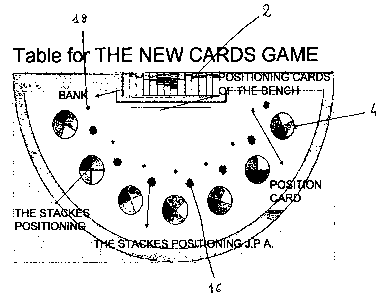Some of the information on this Web page has been provided by external sources. The Government of Canada is not responsible for the accuracy, reliability or currency of the information supplied by external sources. Users wishing to rely upon this information should consult directly with the source of the information. Content provided by external sources is not subject to official languages, privacy and accessibility requirements.
Any discrepancies in the text and image of the Claims and Abstract are due to differing posting times. Text of the Claims and Abstract are posted:
| (12) Patent Application: | (11) CA 2617735 |
|---|---|
| (54) English Title: | THE NEW CARDS GAME |
| (54) French Title: | NOUVEAU JEU DE CARTES |
| Status: | Deemed Abandoned and Beyond the Period of Reinstatement - Pending Response to Notice of Disregarded Communication |
| (51) International Patent Classification (IPC): |
|
|---|---|
| (72) Inventors : |
|
| (73) Owners : |
|
| (71) Applicants : |
|
| (74) Agent: | ROBIC AGENCE PI S.E.C./ROBIC IP AGENCY LP |
| (74) Associate agent: | |
| (45) Issued: | |
| (86) PCT Filing Date: | 2006-07-27 |
| (87) Open to Public Inspection: | 2007-02-15 |
| Availability of licence: | N/A |
| Dedicated to the Public: | N/A |
| (25) Language of filing: | English |
| Patent Cooperation Treaty (PCT): | Yes |
|---|---|
| (86) PCT Filing Number: | PCT/IT2006/000581 |
| (87) International Publication Number: | WO 2007017913 |
| (85) National Entry: | 2008-02-01 |
| (30) Application Priority Data: | ||||||
|---|---|---|---|---|---|---|
|
The New Cards Game a young and dynamic game can be considered at par with the advantage of the payment, and of easy execution for the houses. In The New Cards Game there are four winning combinations, red, black, equal, contrary, that are among them twos twos winners or lost. The possibility to play for the win of a JACKPOT that every casino will decide than, and at the same time to insure himself /herself /themselves against the possible balance with the dealer, and therefore against the loss of halve of the stackes . The New Cards Game can be played on a table similar to the table of BLACK JACK and therefore in casinos, further it could be implemented in a slot machines or in a computer .
L'invention concerne un nouveau jeu de cartes, jeune et dynamique, qui est avantageux pour les maisons de jeu tant du point de vue du paiement que de sa facilité d'exécution. Ce nouveau jeu comporte quatre combinaisons gagnantes, rouge, noir, égales et contraires, y compris deux gagnantes et deux perdantes. Chaque casino décide de la possibilité de jouer en vue du gain d'un JACKPOT, et peut en même temps se prémunir contre un éventuel solde de jeu, et par conséquent contre la perte égale à la moitié des mises faites. Ce nouveau jeu se joue sur une table similaire à celle du black-jack, dans des lieux de réunion tels que des casinos, et peut également être mis en oeuvre dans des machines à sous ou dans l'ordinateur de la maison de jeu.
Note: Claims are shown in the official language in which they were submitted.
Note: Descriptions are shown in the official language in which they were submitted.

2024-08-01:As part of the Next Generation Patents (NGP) transition, the Canadian Patents Database (CPD) now contains a more detailed Event History, which replicates the Event Log of our new back-office solution.
Please note that "Inactive:" events refers to events no longer in use in our new back-office solution.
For a clearer understanding of the status of the application/patent presented on this page, the site Disclaimer , as well as the definitions for Patent , Event History , Maintenance Fee and Payment History should be consulted.
| Description | Date |
|---|---|
| Application Not Reinstated by Deadline | 2010-07-27 |
| Time Limit for Reversal Expired | 2010-07-27 |
| Deemed Abandoned - Failure to Respond to Maintenance Fee Notice | 2009-07-27 |
| Small Entity Declaration Request Received | 2008-05-27 |
| Small Entity Declaration Determined Compliant | 2008-05-27 |
| Inactive: Cover page published | 2008-04-25 |
| Letter Sent | 2008-04-22 |
| Inactive: Notice - National entry - No RFE | 2008-04-22 |
| Inactive: First IPC assigned | 2008-02-24 |
| Application Received - PCT | 2008-02-22 |
| National Entry Requirements Determined Compliant | 2008-02-01 |
| Application Published (Open to Public Inspection) | 2007-02-15 |
| Abandonment Date | Reason | Reinstatement Date |
|---|---|---|
| 2009-07-27 |
The last payment was received on 2008-07-23
Note : If the full payment has not been received on or before the date indicated, a further fee may be required which may be one of the following
Please refer to the CIPO Patent Fees web page to see all current fee amounts.
| Fee Type | Anniversary Year | Due Date | Paid Date |
|---|---|---|---|
| Basic national fee - standard | 2008-02-01 | ||
| Registration of a document | 2008-02-01 | ||
| MF (application, 2nd anniv.) - small | 02 | 2008-07-28 | 2008-07-23 |
Note: Records showing the ownership history in alphabetical order.
| Current Owners on Record |
|---|
| LAB GAMES S.R.L. |
| Past Owners on Record |
|---|
| ANDREA FOFFANO |